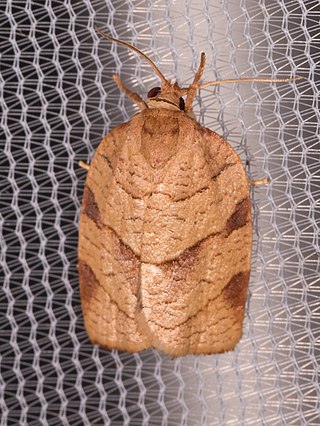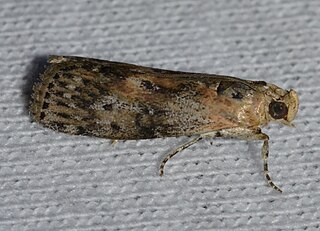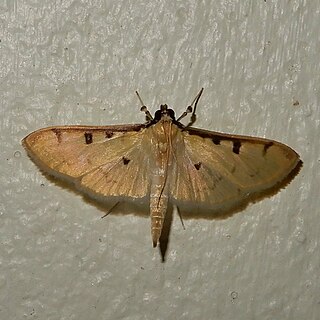Canna leaf roller refers to two different Lepidoptera species that are pests of cultivated cannas. Caterpillars of the Brazilian skipper butterfly, also known as the larger canna leaf roller, cut the leaves and roll them over to live inside while pupating and eating the leaf. In addition, caterpillars of the lesser canna leaf roller, a grass moth, will sew the leaves shut before they can unfurl by spinning a silk thread around the leaf. The resultant leaf damage can be distressing to a gardener.

Chytolita is a monotypic litter moth genus of the family Erebidae erected by Augustus Radcliffe Grote in 1873. Its only species, Chytolita morbidalis, the morbid owlet moth or morbid owlet, was first described by Achille Guenée in 1854. It is found in large parts of North America, from coast to coast in the north and south to North Carolina, Texas and Florida in the west. The habitat consists of deciduous woods and edges.

Schinia nubila, the camphorweed flower moth or brown flower moth, is a moth of the family Noctuidae. The species was first described by Herman Strecker in 1876. It is found from the US states of Oklahoma to New Jersey, south to Florida and Texas. Its range is expanding in the northeast. Furthermore, recorded from Colorado, Kansas, Oklahoma, Arkansas, North Carolina, South Carolina and Maryland.

Archips negundana, the larger boxelder leafroller, is a moth of the family Tortricidae. The species was first described by Harrison Gray Dyar Jr. in 1902. It is found in North America from southern British Columbia to southern Quebec, south to California and Florida.

Calpodes ethlius, the Brazilian skipper, larger canna leafroller or canna skipper, is a butterfly of the family Hesperiidae. It is found in the United States from southern Florida and southern Texas, south through the West Indies, Mexico, and Central America to Argentina. Strays and temporary colonies can be found north to southern Nevada, northern Texas, Illinois and Massachusetts.

Ategumia ebulealis, the clidemia leafroller, is a moth of the family Crambidae. The species was described by Achille Guenée in 1854. It is found in Central America, the Antilles, and the south-eastern United States. It was thought to be introduced to Hawaii, but later research concluded it was actually Ategumia matutinalis which was released.
Nelphe carolina, the Florida eucereon or Little Carol's wasp moth, is a moth of the subfamily Arctiinae. The species was first described by Henry Edwards in 1887. It is found in southern Texas, Florida, Mexico and on Cuba.
Argyrotaenia kimballi, Kimball's leafroller moth, is a species of moth of the family Tortricidae. It is found in the United States, where it has been recorded from Alabama, Florida, Louisiana, Maryland, Mississippi, North Carolina, South Carolina, Tennessee and Texas.

Argyrotaenia tabulana, the jack pine tube moth or lodgepole needletier moth, is a species of moth of the family Tortricidae. It is found in North America, where it has been recorded from Alabama, Arkansas, British Columbia, Florida, Georgia, Indiana, Louisiana, Maine, Maryland, Massachusetts, Mississippi, New Jersey, New York, North Carolina, Ohio, Oklahoma, Pennsylvania, South Carolina and West Virginia.

Argyrotaenia juglandana, the hickory leafroller moth, is a species of moth of the family Tortricidae. It is found in North America, where it has been recorded from Alabama, Arkansas, Florida, Illinois, Indiana, Kentucky, Louisiana, Maryland, Mississippi, Missouri, New Hampshire, New York, North Carolina, Ohio, Ontario, Pennsylvania, Quebec, Tennessee, Texas, West Virginia and Wisconsin. The habitat consists of deciduous woodlands and parks where hickory grows.

Choristoneura obsoletana is a species of moth of the family Tortricidae. It is found in the United States, where it has been recorded from Alabama, Arkansas, California, Florida, Illinois, Kansas, Louisiana, Maine, Massachusetts, Mississippi, Missouri, New Mexico, North Carolina, Ohio, Oklahoma, Oregon, South Carolina, Tennessee, Virginia and West Virginia.

Choristoneura parallela, the parallel-banded leafroller moth, is a species of moth of the family Tortricidae. It is found in North America, where it has been recorded from California, Florida, Georgia, Indiana, Kentucky, Maine, Maryland, Michigan, Mississippi, New Jersey, North Carolina, Ohio, Oklahoma, Quebec, Saskatchewan, South Carolina, Tennessee, Virginia and West Virginia.

Argyria nummulalis is a moth in the family Crambidae. It was described by Jacob Hübner in 1818. It is found in North America, where it has been recorded from Alabama, Florida, Georgia, Kansas, Maryland, Massachusetts, Mississippi, North Carolina, Pennsylvania and South Carolina.
Donacaula maximellus is a moth in the family Crambidae. It was described by Charles H. Fernald in 1891. It is found in North America, where it has been recorded from Florida, Georgia, Louisiana, Mississippi, Nebraska, North Carolina and South Carolina.
Leptosteges flavicostella is a moth in the family Crambidae. It was described by Charles H. Fernald in 1887. It is found in North America, where it has been recorded from Florida, South Carolina and Georgia.

Acleris chalybeana, the lesser maple leafroller moth, is a species of moth of the family Tortricidae. It is found in North America, where it has been recorded from Arkansas, Connecticut, Florida, Illinois, Indiana, Kentucky, Maine, Maryland, Mississippi, New Hampshire, New Jersey, New York, North Carolina, Ohio, Ontario, Pennsylvania, Quebec, South Carolina, Tennessee, West Virginia and Wisconsin.

Acleris maculidorsana, the stained-back leafroller moth, is a species of moth of the family Tortricidae. It is found in North America, where it has been recorded from Arkansas, Florida, Georgia, Kentucky, Maine, Maryland, Massachusetts, Michigan, Mississippi, New Jersey, North Carolina, Ohio, Ontario, Pennsylvania, South Carolina, Tennessee, Virginia and Wisconsin.

Glyphodes pyloalis, the lesser mulberry snout moth, lesser mulberry pyralid or beautiful glyphodes moth, is a moth in the family Crambidae. It was described by Francis Walker in 1859. It is found in Iran, China, Japan, India, Indonesia (Sumatra), Sri Lanka, Taiwan, the Democratic Republic of the Congo, Equatorial Guinea, Mozambique and North America, where it has been recorded from Florida, Maryland, North Carolina, South Carolina and Virginia.

Sciota virgatella, the black-spotted leafroller moth, is a species of snout moth in the genus Sciota. It was described by James Brackenridge Clemens in 1860. It is found in North America, where it has been recorded from Arkansas, Florida, Georgia, Illinois, Indiana, Maine, Maryland, Massachusetts, Minnesota, New Jersey, New York, North Carolina, Ohio, Oklahoma, Ontario, Pennsylvania, Quebec, South Carolina, Tennessee, Texas, Virginia and West Virginia.

Lygropia tripunctata, commonly known as the sweetpotato leafroller, is a species of moth in the family Crambidae. It was first described by Johan Christian Fabricius in 1794. It is found in the United States, where it has been recorded from Texas to South Carolina and Florida. It is also found from the West Indies and Central America to Brazil.














